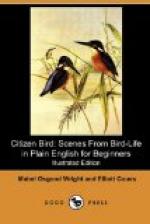“These Herons only wear their beautiful plumes in the nesting season, when it is the height of cruelty to kill birds of any kind, and this is what happens: When the nests, which are built of sticks in bushes and trees above the lagoons, are filled with young, as yet too feeble to take care of themselves, and the beautiful parents are busy flying to and fro, attending to the wants of their helpless nestlings, the plume-hunters glide among them noiselessly, threading the watercourses in an Indian dug-out or canoe, and when once within the peaceful colony, show themselves with bold brutality. For well they know that the devoted parents will suffer death rather than leave their young in such danger.
“Shot upon shot rings out in repeated volleys, each followed in turn by the piteous cries of wounded birds, till the ground is strewn with hundreds of the dead and dying. Then the cruel hunters tear off the plume-tuft from the back of each victim, as the savage does a human scalp, and move on in search of another heronry, to repeat this inhuman slaughter of the innocents.
“But this is not all—what becomes of the young birds? They must either perish slowly of hunger, or be swallowed by the snakes that infest such places and are attracted to the nests by the clamoring of the starving orphans. Now do you wonder that I call this beautiful Snowy Egret the Bonnet Martyr?”
“I never, never will wear any kind of bird’s feathers again,” said Dodo; “and when I go back to school I am going to make a guild for people who will promise not to either. Are Ostriches killed for their feathers, Uncle Roy? Because my best winter hat has a curly row all round the crown.”
“No. Ostrich plumes are a perfectly harmless decoration, for the bird earns his own and his master’s living by growing them, without losing his life. They are the only kind of feathers that should ever be worn for ornament.”
“Has the Great Blue Heron pretty feathers like a Bluebird?” asked Nat, who felt sorry for the fate of the Egrets, but did not like to show it and so tried to turn the subject.
“He is of a slate-gray color, which you might not think blue at all, and he too wears fine plumes, on his head, breast, and back. He is the largest bird of our hundred, being quite as tall as you are, Miss Dodo. If you ever see one of these birds standing on the edge of the mill pond, you will never forget it; for it does not seem like an American bird, but rather like a visitor from strange lands. You may imagine it to be an Egyptian princess in disguise, waiting for a barge to come down the river, rowed by black slaves and conveying a prince all glittering with jewels, who is bringing a ring cut with mystic letters to break the spell—as such things are managed in fairy tales.
[Illustration: Blue Heron.]
“This Blue Heron, you will find, has no sweeter voice than his night-flying cousin, and, like the latter, nests in colonies in the trees; but afterward he travels about alone, as the Bittern does.”




